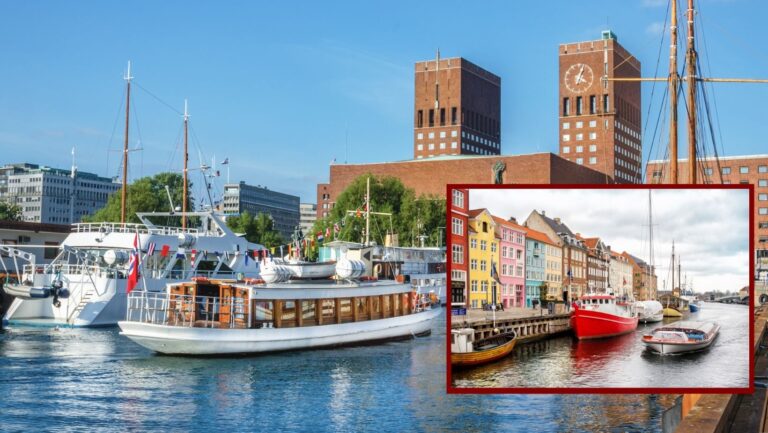Planning a trip from Oslo to Copenhagen? As of 2025, you can fly, take a train, ride an overnight ferry, drive, or hop on a long‑distance bus. Each option offers distinct balances of speed, comfort, price, and environmental impact.
What's the best way to travel between Oslo and Copenhagen? It’s a question I’m often asked by international visitors planning their first trip to Scandinavia, as well as locals looking for the most practical way to get between the two capitals.

For many tourists, Scandinavia is a once-in-a-lifetime destination, and they want to make the most of it by seeing as much as possible. That often means including these two Scandinavian capital cities on the same itinerary.
But it’s not just travellers passing through. Plenty of Oslo residents head to the Danish capital regularly, whether for business meetings, family visits, concerts, or just a weekend escape.
Copenhagen offers a vibrant blend of canals, cycling culture, design, and world-class dining, while Oslo charms with its fjord setting and access to nature. Each city has its own character, and travelling between them is a great way to experience the diversity of Scandinavia.
Flying is the default choice for many, but it’s not the only option. With growing interest in low-emissions travel and alternative experiences, it’s worth comparing all the ways to get from Oslo to Copenhagen—by air, land, or sea.
🇩🇰 Copenhagen Travel Resources
🎨 My Recommendations of Things To Do in Copenhagen
🛏️ Find the Best Deals on Copenhagen Hotels
🚘 Book Your Car Rental in Copenhagen
👣 Discover the Best Tours & Experiences in Copenhagen
🚨 Don't Forget Your Travel Insurance
Oslo to Copenhagen by Air
For most travellers, flying is the quickest and most convenient way to travel between Oslo and Copenhagen. The flight itself takes just over one hour, with dozens of departures each day from Oslo Gardermoen Airport to Copenhagen Kastrup.
The route is served by both Scandinavian Airlines (SAS) and Norwegian, with flights operating throughout the day from early morning to late evening.
With so many options, it’s relatively easy to find a flight that fits your schedule, even on short notice. During peak periods, there can be as many as 20 departures per day.

Flyr, a former Norwegian budget airline, used to serve the route but ceased operations in early 2023.
Copenhagen Airport is a major hub for SAS and connects well with long-haul and European flights, making this a popular route not only for those visiting both cities, but also for travellers catching onward connections. Oslo Gardermoen is similarly well connected and easy to reach via express train from the city centre.
Ticket prices vary widely depending on when you book, the time of day, and how much flexibility you want. If you book in advance, it’s often possible to find one-way fares from around NOK 400–600 (approximately €40–60). Last-minute bookings or peak-time flights may cost NOK 1,200 to NOK 2,000, or even more.
While the flight itself is short, it’s worth factoring in the time and cost of getting to and from the airports, security checks, and possible delays. In real terms, the total travel time door-to-door usually ends up around three to four hours.
That said, for business travellers or anyone short on time, flying remains the fastest way to cover the distance between the two capitals. Both SAS and Norwegian offer low-cost fares with the option to add extras, such as checked luggage, seat selection, or fast-track access, depending on your needs.
The train from Oslo to Copenhagen
There is no direct train between Oslo and Copenhagen, but the journey is still possible, and even enjoyable, by connecting through Sweden. The most common route involves travelling first to Gothenburg and then continuing on to Copenhagen via Malmö.
The entire journey typically takes around seven hours, depending on connections. You’ll travel with a combination of Vy from Oslo to Gothenburg and then with Öresundståg, the Swedish–Danish regional service, for the remainder of the trip.
A transfer in Malmö or Lund may be required on the second leg, but the connection is usually straightforward.

There’s no need to book through tickets, though some platforms allow it. In practice, it’s usually cheapest to book the two legs separately, especially if you’re flexible on travel times. Expect to pay around NOK 800–1,200 in total, though early bird fares can be significantly cheaper.
While it’s not the fastest option, train travel offers scenic views, comfortable seating, and the satisfaction of a lower-emissions journey. You also have the option to break up your trip with a stay in Gothenburg, which makes for an excellent detour.
Trains depart several times per day, so while planning ahead is wise, there’s plenty of flexibility for last-minute travellers too.
Oslo to Copenhagen by Ferry
The two capitals remain connected by a daily overnight ferry, but the operator has changed. In late 2024, Sweden’s Gotlandsbolaget took over the route from DFDS and rebranded the service as Go Nordic Cruiseline.
The crossing is operated by two newly renovated ships, Nordic Pearl and Nordic Crown, which previously sailed as Pearl Seaways and Crown Seaways under DFDS.
The ships have been given a fresh Nordic-inspired makeover, with upgraded cabins, redesigned lounges, and new restaurants showcasing Scandinavian cuisine.
Departures leave Oslo daily at 4.30pm, arriving in central Copenhagen the next morning at 10am. The journey takes around 17.5 hours, and while that may sound slow, the experience feels more like a short cruise than simple transportation.
Each ship offers a wide range of cabins, from basic berths to luxury suites, along with onboard entertainment, shopping, and dining options. Whether you're travelling for leisure or simply want a more relaxed alternative to flying, the ferry provides a scenic and comfortable way to journey between the two cities.
Ticket prices vary depending on the season, cabin choice, and how early you book, but fares typically range from €45 for a basic seat to €250 or more for premium cabins.

Mini-cruise packages are also available for those wishing to enjoy a short round trip with a few hours ashore in Copenhagen. These run both ways, so are also ideal for those based in or near the Danish capital city.
Driving from Oslo to Copenhagen
If you have access to a car, driving between Oslo and Copenhagen offers the greatest flexibility of any travel option, especially with regards to transporting people and luggage.
The journey covers around 600 kilometres (373 miles) and typically takes between six and six-and-a-half hours, depending on traffic, weather, and your chosen route.
The drive takes you through southern Norway and across western Sweden, offering the opportunity to make scenic stops in places like Gothenburg, Varberg, or Malmö, before crossing the iconic Øresund Bridge into Denmark. For those who enjoy road trips, it’s a great way to turn a travel day into part of the adventure.
If you’re renting a vehicle, be sure to check the terms of your rental agreement—not all companies allow cross-border travel, and some may charge an additional fee for international use.
When budgeting for the drive, don’t forget to include the cost of fuel, toll roads, and the Øresund Bridge crossing, which currently costs DKK 459 for a standard car when paid online in advance.
Norway and Sweden also use automatic toll systems, so ensure your vehicle is equipped and registered correctly to avoid fines.
Oslo to Copenhagen by Bus
Long-distance bus services are not as popular in Scandinavia as they once were. Nevertheless, the Oslo to Copenhagen route remains a firm favourite amongst budget travellers.
🇩🇰 Copenhagen Travel Resources
🎨 My Recommendations of Things To Do in Copenhagen
🛏️ Find the Best Deals on Copenhagen Hotels
🚘 Book Your Car Rental in Copenhagen
👣 Discover the Best Tours & Experiences in Copenhagen
🚨 Don't Forget Your Travel Insurance
Vy Buss typically operates three daily services with fares starting at NOK 450 for the 8-hour journey. More often than not, this is the cheapest way to travel between the two cities when booked in advance.
One of the three daily services is an overnight service. For the ultimate budget travel experience, the overnight route will save you forking out for a hotel, if you're the kind of person that can sleep in a moving vehicle, of course. I'm certainly not!
Flixbus is another bus provider with similar fares to Vy. In fact at the time of writing, some fares were available for as low as NOK 400. As with Vy, one of the Flixbus departures tends to be an overnight service.
Whichever route you choose, travelling between Oslo and Copenhagen is easy, rewarding, and a memorable way to link two very different but equally fascinating Scandinavian capitals. What's your preference?


Love this week’s article. The travels between Norway and Copenhagen.
Thank you
Bergen is the first choice!
Bergen by rail to Oslo is a must.
Oslo to Copenhagen by ferry was a treat!!